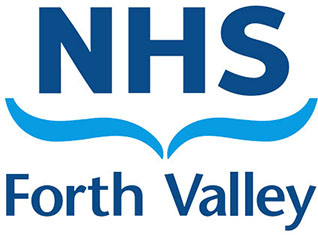NHS Forth Valley Stroke Service delivers Stroke and TIA care (Transient Ischemic Attack) to the population of 300,000.
Each year around 500 people are admitted to Forth Valley Royal Hospital with acute stroke and a further 200 present to our outpatient TIA service.
- Suspect a stroke? Think FAST!
The NHS Forth Valley Stroke team aim to provide patient centred care, supported by effective multi-disciplinary input, mutual respect of patient, carer and staff, underpinned by reflective practice and evidence based care.
Stroke Journey
Acute Admission and Immediate Treatment
Once admitted to the Emergency department, a patient will be assessed to determine whether they have had a stroke. If a stroke is thought likely they will be immediately taken to a CT scanner to find out whether their stroke has been caused by a blocked artery (an ‘ischaemic stroke’) or a burst artery (a ‘haemorrhagic stroke’).
Within NHS Forth Valley Thrombolysis treatment can be offered to those admitted with an ischaemic stroke, presenting within four hours and meeting the administration criteria. However this is still not suitable for all. If Thrombolysis is administered, immediate after care is provided within the Intensive Care Unit, FVRH, before transferring to the Acute Stroke Unit, usually the next day. This is to monitor for any adverse effects of the treatment.
The in-patient service can be provided across Forth Valley within Forth Valley Royal Hospital initially. Patients may then require further rehabilitation or discharge planning within one of the four community hospitals (Stirling, Clackmannanshire, Falkirk and Bo’ness).
Acute Stroke Care
Acute Stroke & Rehabilitation Unit
B21/22, Forth Valley Royal Hospital
Stirling Road
Larbert
FK5 4WR
Phone: 01324 567325
Situated within Wards B21/22, Forth Valley Royal Hospital, is a 30-bedded integrated stroke unit providing acute care and rehabilitation within a multi-disciplinary setting. B21/22 have a dedicated stroke multi-disciplinary team, consisting of stroke consultants, skilled stroke nurses, and Stroke specialist Physiotherapy, Occupational Therapy, Speech and language therapy and Dietetics. There is also a designated ward pharmacist.
The ward consists of four 4 bedded bays and 14 single side rooms.
Wallace Suite
Bellfield Centre
Stirling Health and Care Village
Livilands
Stirling
FK7 2AU
Phone: 01786 444803
The Wallace Suite comprises of 8 dedicated stroke rehabilitation beds. Stroke specific rehabilitation is provided by a multidisciplinary team consisting of nurses, Physiotherapists, Occupational Therapists , Speech and Language Therapists, and Dietetics.
Patients who are transferred to the Wallace Suite from A22, FVRH, have continued to meet their stroke specific rehabilitation goals. They therefore continue to require specific, targeted, and measurable stroke care.
For other patients who are not identified as appropriate for the Wallace Suite, they may be discharged home to continue their rehabilitation with one of our community teams. This may be multi-disciplinary input with one of the community ReACH teams, or uni-disciplinary, for example with only Speech and Language Therapy input. Occasionally patients may feel they require ongoing input that has not been identified in hospital. These issues can be discussed with your GP or by accessing the teams as mentioned below.
Please click on links below for further information:
- Rehabilitation Care Group (includes Single Point of Referral details)
- Speech and Language Therapy
- Occupational Therapy
- Dietetics
Rehabilitation and Discharge Planning
However, for many in-patients they may achieve their potential for recovery during their time within A22. At this time it is discussed with the patient, their family or carers, and the multi-disciplinary team regarding future care needs. A decision will be taken at this time to decide if patients are suitable for a discharge home with carer support or if they still require discharge planning within a community hospital until appropriate carer services can be identified.
If a transfer to a local community hospital is suggested, their care needs will continue to be met by a multi-disciplinary team of doctors, nurses and therapy staff, but the main goals will be to ensure a smooth transition from hospital setting into a homely environment (home, sheltered accommodation, care home, etc).
Patient Information
Stroke Specific Services
Transient Ischaemic Attack (TIA) Clinic
A transient ischaemic attack (TIA) or ‘mini stroke’ is caused by a temporary disruption in the blood supply to part of the brain. The disruption in blood supply results in a lack of oxygen to the brain. This can cause symptoms similar to those of a stroke, such as speech and visual disturbance and numbness or weakness in the arms and legs. However, a TIA does not last as long a stroke. The effects only last for a few minutes and are usually fully resolved within 24 hours.
A specific rapid access TIA service is provided within FVRH, giving rapid diagnosis, assessment and access to specialist care for high risk patients. The clinic runs Monday to Friday in morning sessions within the Outpatients Department.
Occasionally, a diagnosis of TIA is NOT given and in these cases, you may be signposted or referred on to other services.
TIA Clinic Administrator
Clinical Offices
Forth Valley Royal Hospital
Larbert
FK5 4WR
Phone: 01324 566064
Stroke Education
As part of the services offered, the Stroke team also provide education to other professionals,
These programmes can include:
- Stroke and TIA Assessment Training (STAT)
- Core Competencies Stroke Study Day
- Advanced Competencies Stroke Study Day
Please discuss with Stroke team or look out for details on NHS Forth Valley Training Programme.
Further Information
There are also many national campaigns, charities, and support networks for patients and families/carers affected by stroke.


